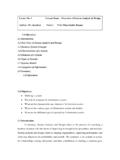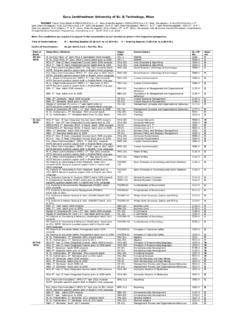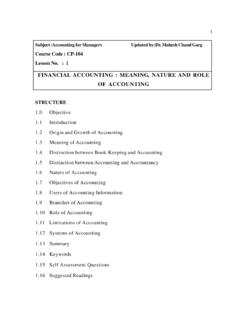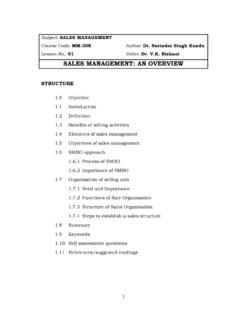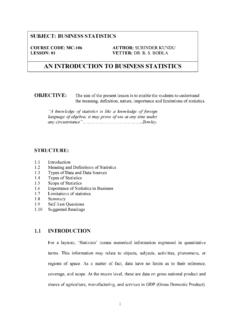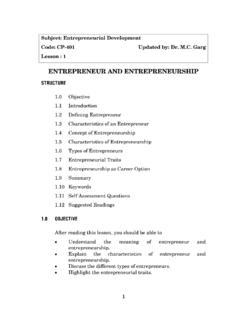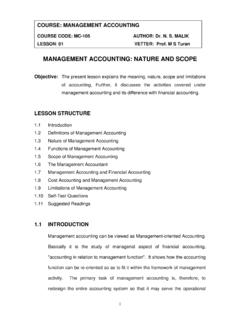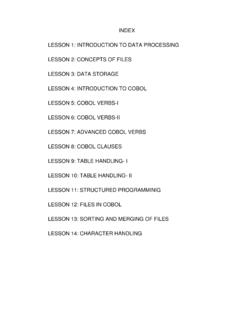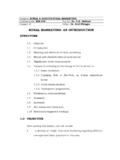Transcription of Lesson No. 1 TRAINING PROCESS – AN OVERVIEW; ROLE ...
1 OBH 412 MANAGEMENT TRAINING & DEVELOPMENT Lesson No. 1 TRAINING PROCESS AN OVERVIEW; ROLE, RESPONSIBILITIES AND CHALLENGES TO TRAINING MANAGER Author: Dr. Tejinder Sharma Dept. of Commerce, , Kurukshetra Structure: Objective Introduction Need and Rationale of TRAINING Definition of TRAINING Objectives of TRAINING TRAINING , Development and Education Significance of TRAINING Benefits of TRAINING to Employers Benefits of TRAINING to Employees Changing Facets of TRAINING Roles and Responsibilities for the Trainers Summary Key Words Self Assessment Questions Suggested Reading Objective After reading this Lesson , you will be able to.
2 Define TRAINING Understand the need and rationale of TRAINING Appreciate the benefits of TRAINING to the employees and the organization Know the role of the trainers in the rapidly changing economy Introduction In the knowledge driven world of today, the pace of change is so fast that it even defies Moor s law. Even to stay at the same place, the organizations have to run fast. Strategic advantage to the organizations comes only from the core competences, which are developed by the individuals working in it. Such levels of excellence can be achieved only by investing in people. Investment must not confine to compensation only, but must entail the inputs aimed at updating the skills of the employees.
3 TRAINING is one such potion to cure the organizations of the sluggishness, which may creep in because of the organizational inertia. Largely, personnel department has been associated with procuring and hiring the human resources. But, after the newly appointed employees join the organization, it is necessary to impart TRAINING to them in order to make them competent for the jobs that they are supposed to handle. In modern industrial environment, the need for TRAINING of employees is widely recognized to keep the employees in touch with the new technological developments. Every company must have a systematic TRAINING programme for the growth and development of its employees.
4 It may be noted that term TRAINING is used in regard to teaching of specific skills, whereas the term development denotes overall development of personality of the employees. This chapter studies the various methods of TRAINING and development, which are used by various organizations, particularly those engaged in the business and industrial activities. Need and Rationale of TRAINING TRAINING is important, not only from the point of view of the organization, but also for the employees. It gives them greater job security and an opportunity for career advancement. A skill acquired through TRAINING is an asset for the organization and the employee.
5 The benefits of TRAINING stay for a very long time. TRAINING can become obsolete only when there is a complete elimination of the desired for that skill and knowledge, which may happen because of the technological changes. In general terms, the need for TRAINING can arise because of the following reasons: (i) Changing Technology. Technology is changing at a fast pace. Be it any industry, technological changes are changing the way in which operations were done. Newer machines are being used for automation of the processes. Computers have made the controls very easy. Advances in information technology have enabled greater degree of coordination between various business units, spread far across the globe.
6 In order to keep themselves abreast with the changes, the employees must learn new techniques to make use of advances in the technology. TRAINING needs to be treated as a continuous PROCESS to update the employees in new methods and procedures. (ii) Demanding Customers. As the free markets become stronger, customers are becoming more and more demanding. They are much more informed about the products. They have many sources of 3information. Intensified competition forces the organizations to provide better and better products and services to them. Added to the customer conscious, their requirements keep on changing.
7 In order to satisfy the customers and to provide best of the quality of products and services, the skills of those producing them need to be continuously improved through TRAINING . (iii) Thrust on Productivity. In the competitive times, organizations cannot afford the extravaganza of lethargy. They have to be productive in order to survive and grow. Continuous improvement of the employees skills is an essential requirement for maintaining high standards of productivity. Productivity in the present times stems from knowledge, which has to be relearned continuously. (iv) Improved motivation. TRAINING is a source of motivation for the employees as well.
8 They find themselves more updated while facing the challenging situations at job. Such skill development contributes to their career development as well. Motivated employees have lesser turnover, providing an organization with a stable work force, which ahs several advantages in the long run. (v) Accuracy of output Trained workers handle their job better. They run their machines safely. They achieve greater accuracy is whatever job they do. This reduces accidents in the organizations. Adherence to accuracy infuses high standards of quality in 4the products and services, thus giving them a competitive edge in the difficult times.
9 Quality reduces wastages and ensures better customer satisfaction. (vi) Better Management. TRAINING can be used as an effective tool of planning and control. It develops skills of the workers for future and also prepares them for promotion. It helps them in reducing the costs of supervision, wastages and industrial accidents. It also helps increase productivity and quality. Definition of TRAINING TRAINING is often looked upon as an organized activity for increasing the knowledge and skills of people for a definite purpose. It involves systematic procedures for transferring technical know-how to the employees so as to increase their knowledge and skills for doing specific jobs with proficiency.
10 In other words, the trainees acquire technical knowledge, skills and problem solving ability by undergoing the TRAINING programme. There are several textbook definitions of TRAINING , but the one by Edwin B Flippo is generally well accepted. According to Flippo, TRAINING is the act of increasing the knowledge and skills of an employee for doing a particular job . TRAINING involves the development of skills that are usually necessary to perform a specific job. Its purpose is to achieve a change in the behaviour of those trained and to enable them to do their jobs better. TRAINING makes newly appointed employees fully productive in lesser time. TRAINING is equally necessary for the old employees whenever new machines 5and equipment are introduced and/or there is a change in the techniques of doing the things.

